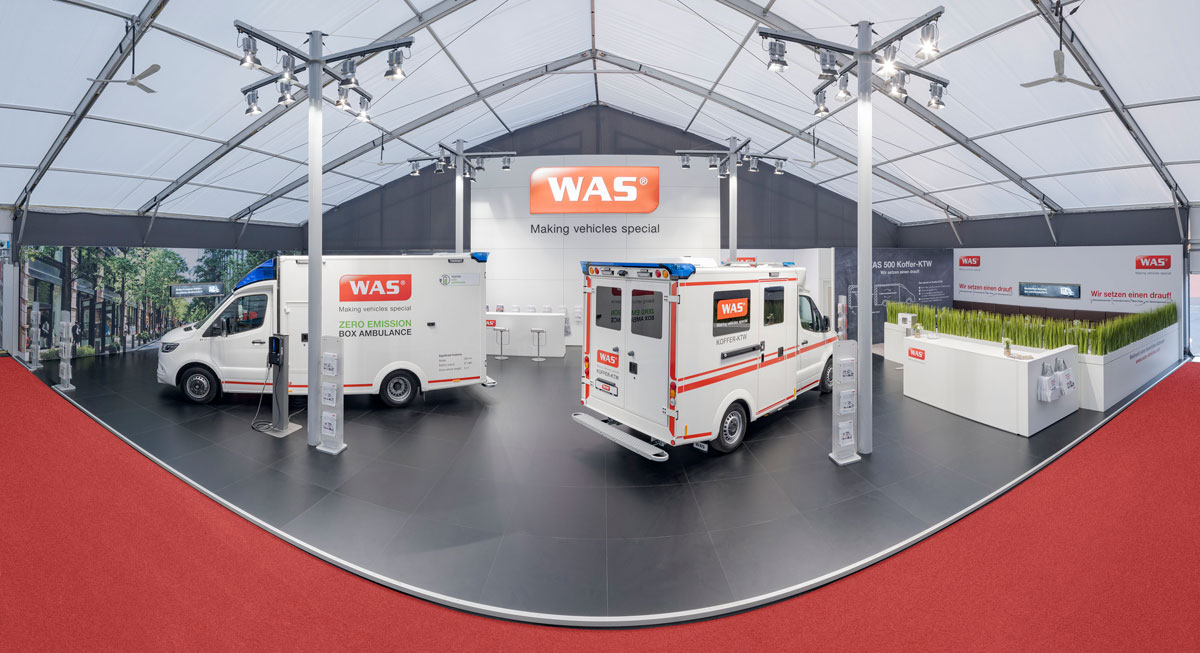

Lightweight, comfortable patient transport: the WAS 500 box body patient transport ambulance
When it comes to rescue vehicles, ambulance and special vehicle manufacturer, WAS, and its international customers, have for several years been increasingly reliant on vehicles with a lightweight box construction. With the WAS 500 box-body patient transport ambulance, patient transport is now also benefitting from the advantages of a base vehicle with a box construction.
More space in the patient compartment, less weight, lower fuel consumption, and reduced lifecycle costs – these factors influence the customer decision in moving away from a panel van construction, to a base vehicle with a box construction. This is a decision that allows room for future progression, as with advancing technical and medical development, the requirements placed, for example, on electro-hydraulic stretcher systems are also increasing. As a result, technical and quality specifications are increasing the weight and dimensions of the motorised stretcher systems from many providers. Here the lightweight box construction offers further advantages: it not only helps reduce weight, so as not to exceed the maximum permitted weight of 3.5 t that applies for the majority of patient transport ambulances, but also guarantees more space in the treatment area. Because there is no need to take rounded edges into account within the add-on box compartment, there is even more storage space for additional equipment, thus enabling the use of the vehicle as an emergency ambulance, for example. "For our clients, keeping the overall weight of a patient transport ambulance as low as possible is often a key selling point, as they are only able to act with true flexibility when the vehicle can be driven by a driver with a Class B licence. An electro-hydraulic stretcher system, in combination with an electronically supported carry chair – this equipment and weight class would not be possible with a panel van ambulance," confirms Andreas Plöger, Managing Director of WAS.
Another advantage that many clients within the field of rescue vehicles have already come to appreciate, is the fact that the box can be re-used on another vehicle once the base vehicle reaches the end of its service life. This not only reduces lifecycle costs, but also has a positive effect on product's environmental impact. Many municipal and private patient transport providers also consider themselves responsible with regard to the environment and their CO2 emissions. With considerable fleet sizes and long distances covered each year, many of these providers consider it important that they keep their emissions to a minimum. The same applies regarding lifecycle costs: less weight means reduced fuel consumption, and therefore reduced emissions as well. Lighter structures have a direct effect on the products' energy balance and environmental impact. And if a box body construction can be put to more long-term and more flexible use, its environmental impact will be reduced.
Series-ready e-mobility for use by emergency services: the WAS 500 E-Ambulance.
The topic of sustainability is taking on even greater significance in the area of e-mobility. In this regard, with the first zero-emission ambulance within the 5.5 t class, WAS already presented a vehicle concept at the RETTmobil 2018 - a concept that was unique within the emergency services sector. Now, in 2022, the company has announced that the concept is series-ready. To this end, WAS first sent a prototype of the E-ambulance on a practical tour through Germany and Europe. The E-ambulance with its box body structure was tested under real-life conditions by rescue organisations and emergency services in a total of 20 cities, and the feedback was analysed. In the process, the vehicle clocked a total of 229 service days, covering 20,784 kilometres during 1,235 call-outs. The result: the testers quickly developed a trust for the new technology, with no faults reported during use. The quiet and dynamic drive properties, with powerful acceleration and good road holding made a particularly positive impression on the test subjects. The feedback from the test phases not only showed that WAS is generally on the right track when it comes to e-mobility in the emergency services, but also gave us important impetus for the development of the concept into a standard production vehicle. In addition to the drive properties and range, WAS also managed to impress with regard to safety and environmental protection. For instance, with LFP batteries (lithium iron phosphate), fire-inhibiting technology is being used, doing away with nickel and cobalt altogether, as the mining of these rare metals is justifiably on the receiving end of criticism.
"Our conclusion is that there will remain nothing standing in the way of the use of electric ambulances in urban areas, just as soon as the available infrastructure has been suitably improved. Battery performance is now more than sufficient, although charging capabilities at all maintenance areas and car parks would further increase trust and render the use of e-mobility more flexible," explains Andreas Plöger, summarising the feedback.
Impressions RETTmobil 2022 in Fulda
Contact:
Wietmarscher Ambulanz- und Sonderfahrzeug GmbH
Simone Bergmann
Head of Marketing & Communication
Darwinstr. 11
D-48488 Emsbüren
s.bergmann@was-vehicles.com
Telephone: +49 5903 93201-170






